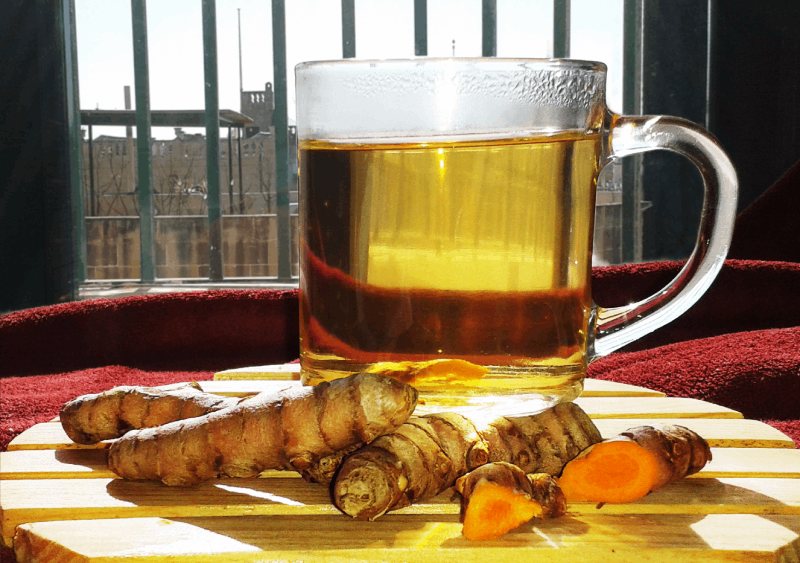It has crossed the bat’s sonar that turmeric, like wasabi, was commonly used as a food disinfectant, so of course, I found it necessary to fly in closer and see what I can find out! Can this be turned into a homemade tea as well? I guess it could, however, is the flavor pleasing? It makes Indian dishes great, however, it’s usually helped by other spices. I can’t imagine drinking a curry dish, so I will look into that too and see what variations we can find that seems interesting enough to try! (To be totally honest I do use it when I make kettles of cold tea, but the amount I drop-in is minimal, so it’s completely drowned by the other ingredients, I will try to find something that revolves more around the turmeric flavor in this article.)
What is Turmeric?
As usual, I would like to start by taking a closer look at our guest ingredient. Turmeric is another flowering plant of the ginger family, and just like we do with ginger, we go for its root, or to be more precise its rhizomes (a kind of subterranean stem that sends out roots and shoots from its nodes). It can grow up to 1 meter in height and has rather large leaves that form a false stem before opening up. The plant is native to the Indian Subcontinent and Southeast Asia, however, it seems that the ‘proper plant’ is the one found in South India, so no wonder I always associate it with Indian cuisine!
Turmeric is composed of carbohydrates (more than half of its weight actually), water, protein, fat, dietary minerals, essential oils, dietary fibers, and curcuminoids (the rest have a rather balanced distribution, however, the ones at the end have a slightly lower percentage than the ones mentioned at the beginning). Among the curcuminoids found in this plant, we can find curcumin, a substance believed to reduce inflammation.
Health Benefits
Thanks to curcumin, turmeric is believed to have antioxidant, anti-inflammatory, antiviral, and antibacterial properties. There is also weak evidence that turmeric extracts may help to relieve symptoms of knee osteoarthritis. But, let’s make a list of all the wonderful benefits I found linked to this ingredient:
- Help to relieve symptoms of arthritis and knee osteoarthritis
- Improve immune function
- Help to reduce heart complications
- Help to prevent cancer
- Improves the digestive system and helps with problems such as irritable bowel syndrome
- Help to prevent Alzheimer’s disease
- Maintains a healthy liver
- Aids in controlling blood sugars
- Helps with lung conditions
- Helps with PMS
Side Effects
The first thing I came across is that it can stimulate contractions (you know, the curry induces labor rumor that has been around for a while?). It is not advised to ingest large doses of turmeric during pregnancy, small amounts as a spice to food shouldn’t cause any problems. Now let’s see what negative side effects I can sniff up for this root:
- Upset stomach
- Blood thinner
- Not ideal during pregnancy
- Skin rash
- Headaches
Making the Tea
- 1/3 teaspoon of Turmeric (grated or powder)
- 1 cups of water
All the recipes I found suggest that you place the turmeric just before the water boils and leave simmering on low heat without boiling for around ten minutes (so maybe today’s root is really stubborn to let go of its aromas and benefits), however, do not boil as boiling will reduce the health benefits. Strain your tea and you’re ready to go! This drink was described as very refreshing especially if you drink it cold, so I know what my next summer tea will be like! As usual, you can add honey for sweetness, and milk or lemon could also be added, however, as promised I will give more variations for this particular tea!
Honey will add to its anti-microbial properties, milk (almond or coconut) or coconut oil will help with absorption (fats help the curcumin be absorbed better in the body), black pepper will also help with this (Yes, a pinch of black pepper is really good with certain teas! You should go ahead and try it, it gives an amazing kick to your teas!!), and last but not least, lemon, lime, and, ginger enhance antioxidant and antimicrobial properties. It can also be added with green tea and with cinnamon, a rather versatile ingredient, right?
Now here is a link to a delicious recipe I found that is a little more complex, so I thought it should have its own spotlight:
Hope you try one of these interesting variations and find a way to benefit from this incredible rhizome! Feel free to leave some comments below about your experiments in the brewing department!

